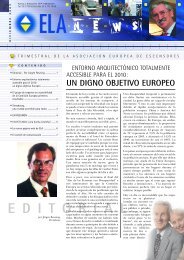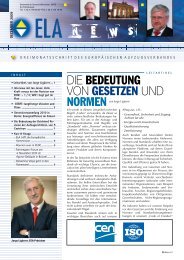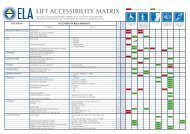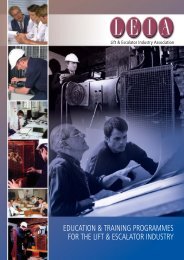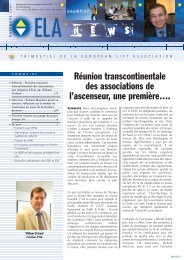WP6-Brochure-E4 brochure - ELA European Lift Association.
WP6-Brochure-E4 brochure - ELA European Lift Association.
WP6-Brochure-E4 brochure - ELA European Lift Association.
Create successful ePaper yourself
Turn your PDF publications into a flip-book with our unique Google optimized e-Paper software.
Table 7‐4. Energy efficiency: Specification<br />
Specification<br />
4 Check necessity of lift or escalator installation<br />
The purpose of elevators and escalators is to provide accessibility to all. Any building with two<br />
levels or more may need elevators and/or escalators for accessibility reasons.<br />
Recommendation: in a building where elevators or escalators already exist, it should be<br />
discussed first whether already existing installations could be modified or extended to satisfy<br />
the transportation capacity while ensuring acceptable waiting time, before adding further<br />
installations.<br />
Relevance: new installations and retrofits located in buildings where more than one vertical<br />
transportation systems are found.<br />
5 Check location and number of installations<br />
Selecting the appropriate location for lifts or escalators can increase comfort and ease for the<br />
users and it can help reduce the number of required installations.<br />
Recommendation: in buildings where several lift installations are planned, different<br />
arrangements of lifts or escalators can be considered. Reducing the number of installations by<br />
one can mean reducing overall consumption, but it has to be addressed together with other<br />
aspects, such as building design, accessibility, traffic handling capacity, acceptable waiting time,<br />
safety, and so on. The location of the lift and escalator should also be analysed, together with<br />
the location of staircases. Easily accessible and attractively designed staircases may contribute<br />
to reducing energy consumption due to a lower frequency of use of the lift or escalator.<br />
Relevance: especially relevant for new installations.<br />
6.5.6. Specific features for energy‐efficient lifts<br />
The previous section dealt with aspects that are relevant both for lifts and escalators. In this<br />
section, features that are specifically relevant for lifts are discussed. The roles of specification,<br />
awareness and knowledge have already been discussed in the previous section. For lifts, the<br />
equipment selection process is further examined, both for the drive system and ancillary<br />
equipment. Then issues concerning the installation process are discussed. Finally, measures<br />
taken during operation are discussed (cf. Figure 7‐3).<br />
Specification<br />
Drive<br />
system<br />
selection<br />
Auxiliary<br />
equipment<br />
selection<br />
Implementation<br />
Operation<br />
Awareness & knowledge<br />
Figure 7‐3. Aspects of energy‐efficiency through the life‐cycle of lifts (source: Fraunhofer ISI)<br />
Aspects of drive systems are discussed in Table 7‐5, aspects concerning ancillary equipment<br />
are treated in Table 7‐6.<br />
107





